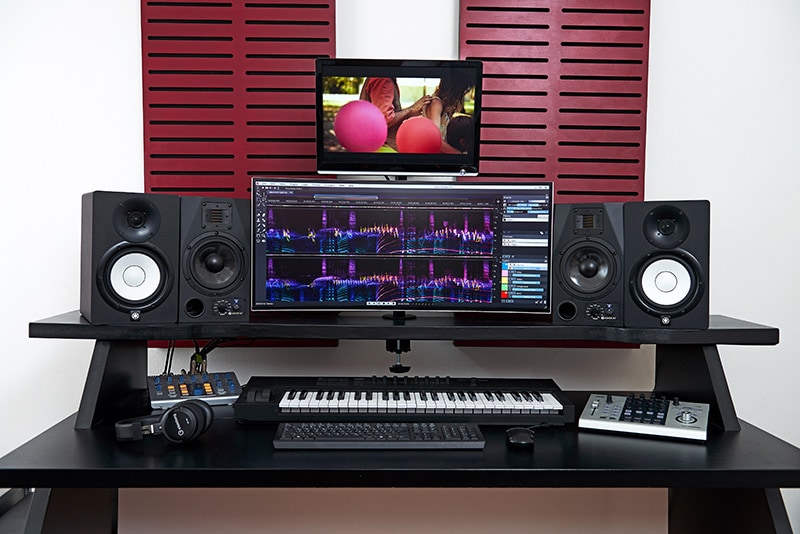SpectraLayers offers a novel approach to precise audio editing by visualizing audio in the spectral domain (in 2D and 3D) and providing an array of powerful tools to manipulate its spectral data in many different ways.
New in Version 7 is the implementation of Artificial Intelligence that allows for the introduction of exciting new features, including automatic pattern detection, clip repair, unmixing tracks to stems as well as unmixing stems to component parts. Other new automated processes include click repair, hum removal and precision spectral de-essing. These features are rounded out by an array of useful enhancements, such as the improved ARA 2 integration with
Cubase and Nuendo, VST 3 plug-in support and much more.
The new Artificial Intelligence in SpectraLayers Pro recognizes distinct events and isolates them by moving them to independent layers that are highlighted for further processing. The AI-assisted unmixing capability in SpectraLayers Pro scans a mixed song and extracts the different instruments within the song to separate layers, adding default settings for vocals, piano, bass, drums and more, while SpectraLayers Elements extracts vocals only. Unmix can also be used on stems, separating these into tone, noise and transient component layers. With its AI technology, SpectraLayers has now also made significant advances in pattern recognition: users can select a target sound and then trigger a search to automatically locate and select every other similar sound in the spectrum.
Great vocal processing tools exclusively available in Pro include the Voice Denoiser that recognizes and isolates the human voice for emphasizing the voice, or the new automatic de-essing for shaping sibilants.
The new AI-driven repair processes consist of Clip Repair for detecting and fixing clipped peaks (available in Pro only), Hum Reduction for eliminating unwanted hum and Click repair for repairing clicks, crackles and pops.
The enhanced Transform tool can preserve formants for more natural-sounding pitch transpositions, and the new Transform Selection tool is another one of many new tools introduced in SpectraLayers 7. It adds corner and midpoint handles that can be dragged to fine-tune selection boundaries, such as adjusting the bandwidth selections made with the Frequency Selection tool. The upgraded Healing tool is now also assisted by AI, resulting in better interpolation and faster performance. The Playback tool now lets users select a specific frequency bandwidth that can then be auditioned anywhere on the spectral graph.
Further additions to SpectraLayers 7 include improved ARA 2 layer management by configuring the layer view as well as VST 3 plug-in processing support for even more plug-in power. UI luminosity is now configurable to provide the brightness that best suits the workplace environment. Many other small useful additions include a playback VU meter, new cut/copy/paste options and more.
Marketing Manager Luis Dongo commented: “SpectraLayers is opening a new, significant chapter with this version. With its AI-powered tools and processes, such as its unmix capabilities that you really have to see for yourself to believe it, both the Pro and the Elements editions of SpectraLayers 7 take audio editing to a completely new level.”
Availability and pricing
Full-license retail versions of SpectraLayers Pro 7 and SpectraLayers Elements 7 are available from resellers and through the Steinberg Online Shop. The suggested retail price for SpectraLayers Pro 7 is US $299.99. The suggested retail price for SpectraLayers Elements 7 is US $79.99.
Various downloadable updates and upgrades are exclusively available through the Steinberg Online Shop.
Customers who have activated SpectraLayers Pro 6 and SpectraLayers Elements 6 since July 6, 2020, are eligible for a free, downloadable Grace Period update to the latest respective version.
New features
- New Artificial Intelligence algorithms that can sense discrete events in a sound field and isolate them on independent, colorful layers for processing.
- Unmix tracks to stems to extract the different instruments to separate layers, such as vocals, piano, bass, drums, and more.
- Unmix components to deconstruct stems into tone, noise and transient component layers.
- Pattern finder to select a target sound and then automatically locate and select every other similar sound in the spectrum (Pro only).
- Voice Denoiser to recognize and isolate the human voice and then attenuate everything but the voice for maximum intelligibility (Pro only).
- Repair processes including AI-powered Click repair and Hum reduction (Pro and Elements) as well as Clip repair and improved Healing (Pro only).
- Improved Playback tool and Transform tool now featuring a new Transform Selection mode.
- Improved ARA 2 layer management creates new layers in the ARA environment.
- VST 3 plug-in support on a per-layer basis, in both standalone and ARA modes.
- Further improvements including customizable UI luminosity, a playback VU meter, rapid tool toggling, the ability to render a selected layer directly and much more.

